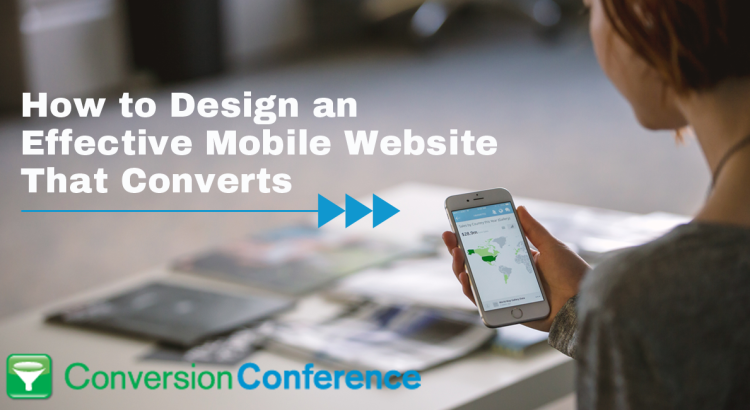Mobile may be the new normal, but it’s still not converting well.
And it’s largely because majority of mobile sites don’t inspire enough confidence in their users. Suffice it to say that in the rush to jump into the mobile bandwagon, a lot of companies either simply miniaturized their desktop sites or turned to responsive web design. Designing a conversion-friendly mobile site takes more than that. It needs planning and attention to data.
If you want your mobile website to be more effective at converting visitors, here are five things to keep in mind:
1. Keep your design simple and fast
Remember Microsoft’s study that showed online users have an attention span shorter than that of a goldfish?
Keep that in mind when designing your mobile site.
If you strive for a clutter-free desktop site, you should do even better on smaller screens. Mobile users are more easily distracted. They’re most likely using their mobiles in settings full of distractions and may even be using multiple devices at once depending on their activity or purpose.
Majority of mobile users visit mobile sites purposefully: they want to get information and get out as fast as they can. They’re more impatient than usual, and have even less tolerance for complicated sites than they have when they’re on a desktop.
So keep your design as simple and light as possible. Streamline your navigation and layout so they include only the essentials. Hide or remove extraneous elements that increases the complexity of your website. For instance, you can use progressive disclosure to reduce clutter from secondary features or content.
Make sure your navigation is easy to understand. Follow mobile web conventions so you avoid confusing your users. Put a text label under your buttons or icons if necessary so people will know what they mean.
Keeping your mobile design down to the basics also works great for faster loading time. Consider this: 40% of online visitors will only wait a maximum of 3 seconds for your page to load. So your website needs to load almost instantaneously if you want to prevent your users from leaving.
2. Match your visitors’ intent
Your visitors will only keep using your mobile site – and convert – if it gives them a good experience.
And good user experience starts with matching user intent.
To do that, you need to know the use-context of your mobile users: why are they visiting your mobile site and what are they trying to do?
Knowing the specific context of your mobile visits is important since intent is usually dependent on context. For instance, a user who’s trying to pass the time by browsing your ecommerce site obviously has a different purpose – and different expectations – from someone who wants to buy something easily and quickly. So whether your users are bored, in a hurry, or are merely looking for information or quick updates will have an impact on their perception of your mobile site’s user experience.
You can uncover use-context using analytics by looking at search data and mobile traffic. Identify who comprise the majority of your mobile users based on search terms and high-traffic pages for mobile. For instance, if you run an ecommerce site and your promo pages are getting more traffic, then you can deduce that most of your mobile users are deal-seekers who want quick updates on coupons or sales. But if you get a disproportionately high amount of traffic to specific products, then it’s likely that you’re getting visitors who are either looking for product/ pricing information or who want to do some quick shopping on your site.
When you already know who the majority of your mobile users are (and if they convert or not on mobile), you can then focus on improving and fixing the pages and experiences that are most relevant to them.
3. Prioritize your users’ conversion goals
What are your users’ conversion goals?
A common mistake for marketers when designing their sites – whether it be on mobile, tablet, or desktop – is to assume that their business and users’ goals are one and the same.
It often isn’t.
Designing your mobile site for conversion requires prioritizing your mobile users’ needs and aligning your business’ objectives with them. Make things that mobile users often do more accessible by putting them upfront on the first screen of your mobile site. If a lot of users are looking for certain information, don’t bury it below the fold or two swipes away just so your store’s ad promotion can take front-and-center of the screen.
Accept the fact that there are times when mobile may not be a conversion device for your visitors. Instead, look for opportunities to turn them into customers either at another time, device, or channel. If your users are mainly browsers, for instance, you should stop pushing for the hard sale. Find out why users are not converting on their phone: could it be the general lack of confidence to transact on mobile or are there serious usability issues or errors on your site?
Pull up your analytics data to learn how mobile users are moving through your site, the pages they frequent, and where they’re dropping off. If data shows that users are simply using your mobile site to browse or webroom (the online equivalent of showrooming), then optimize these visits as forms of micro-conversions.
4. Help mobile visitors fulfill their tasks
Small screens are inherently challenging for users.
To improve conversion rates, make things easier for mobile users by helping them fulfill common tasks.
Beyond making sure your navigation is friendly enough for finger and thumb-tapping, ensure that your navigation elements are organized for an effortless experience. When users tap on a navigation menu, for instance, it should display the most frequently accessed topic or category on your site instead of default sorting. Add click-to-call on your mobile site if data shows that it’s what most of your users are looking for.
You should also pay attention to optimizing on-site search. Most mobile users prefer using the search box to the navigation menu when they want to quickly find content. They also turn to search when they get tangled in complex navigation. Your search box should therefore be prominent and obvious. It should return accurate and highly relevant results.
Typing on a small screen is cumbersome for most users so keep text input to a minimum. It goes without saying that you should also strip down your forms to require only rudimentary information. If you have an e-commerce site, explore other ways for customers to check out without having to manually type in their credit card details or address.
A lot of users find the lack of enough product or service information a big letdown on mobile sites. In fact, it’s often among the reasons that mobile users don’t convert. Afterall, people need data to decide. So give them as much context and details as you can on your mobile pages.
5. Go easy on the extra features
It’s hard to resist the shiny new toys that mobile brings.
But resist you must.
As in your desktop site, you should be very selective with including extra features on your mobile site. Remember that the effectiveness of your mobile site has more to do with great usability and user experience than with any extra you throw in.
This is not to say you shouldn’t add a feature you think would be helpful to users. If it makes sense for you to be maximizing mobile’s GPS and location data capabilities, then why not? Just make sure you have the data to support your assumptions about the bells and whistles and you’ve tested those assumptions before jumping right in.
Remember: only include a feature if it helps users accomplish their task and does not break your site’s accessibility and usability.
Get Ready to Convert on Mobile
Mobile users have to grapple with the difficulties inherent in the mobile form factor. But considering how majority of shoppers and buyers heavily use their mobile devices to accomplish tasks related to pre-purchase decision-making, it shouldn’t be long before they’re comfortable enough with completing their conversion journey on these same devices. The onus is on digital marketers to start removing the barriers to conversion on their mobile sites by focusing on better usability and user experience.
Conversion Conference is evolving into Digital Growth Unleashed! After dozens of shows in the US and Europe since 2010, we are defining a new and more powerful perspective for digital persuasion. Create the most compelling end-to-end customer experiences. Attract, persuade, serve, and the technology to make it happen – we’ve got you covered with four parallel breakout tracks! Plan early and get the absolute lowest rates possible for May 16-17, 2018 at the Mandalay Bay Casino & Resort, Las Vegas.

 717 798 3495
717 798 3495



